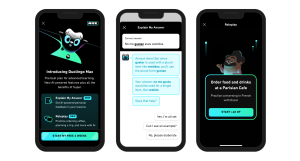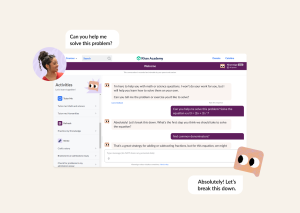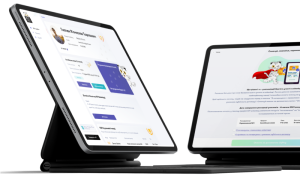Educational technology has gone a long way over the past decade, and its development is accelerating steadily. This evolution is driven by both the possibilities of new tech and the change in teaching methods and approaches, and these two directions constantly fuel each other. This opens up countless new niches and opportunities for the EdTech industry, so let’s look at the top 7 educational technology trends as of 2025 that we think will impact the very way we learn.
A curious thing is that in the “good old days”, learning was basically done in the form of catechism: a standardized set of questions and answers (think medieval FAQ) to be learned by heart. As history progressed, teachers came up with more individualized and efficient methods. With the advent of eLearning, while the technological possibilities were still scarce, education temporarily threatened to slip back into the Dark Ages (this time powered by multiple-choice raw HTML forms), but not for long. Our story today is one of technology getting bolder and finally allowing us to implement the most innovative, inclusive, and convenient learning methods. Sometimes, even inspiring them.
Based on our experience with diverse projects like NIT and many others, we’ve singled out the trends that will most likely impact the public attitude and approach to education in a short-term perspective. And yes, there is no separate “AI in EdTech” section here, because AI and Machine Learning now permeate everything, so there’s actually a fair share of AI in every category we’re talking about.
#1 Personalization and adaptive learning
Personalization has been a big trend in marketing, with companies reporting tremendous improvements in conversion rates and brand awareness thanks to this strategy. With entire generations now having been raised by marketing, it is no surprise that personalized approaches are finding their way into all the other areas of everyday life that require the consumption of information – education being the first in the list. And it works even better than the humanist approach from the pre-digitalization era.
For several years, the main obstacle in personalizing eLearning experiences were the technological limitations: who was going to create personalized learning pathways? Content? Exercises? Now, though, with the advent of AI, the situation has changed.
ML-powered “knowledge graphs”, now used by the likes of Squirrel AI, ALEKS, and Khan Academy, can perform tasks that look like continuous placement tests. While a traditional placement test (like determining your language level before placing you in an appropriate learner group) is done once, AI and ML-driven algorithms can perform adaptive tests as you go, constantly assessing your level of skill acquisition and fine-tuning your learning routine to address possible gaps.
At the same time, generative AI is starting to make its first steps towards being able to produce personalized content. This essentially boils down to not having to reread an entire section of a book to remember one thing you’ve forgotten, but having the algorithm generate a microlearning experience for you, complete with content and exercises, to refresh your skills.

Finally, major educational technology platforms like Duolingo (its paid version, at least) are now introducing personalized feedback and hints to help learners get what traditional eLearning has notoriously failed to do: live, real-time feedback.
#2 Gamification
Humans have liked games since days immemorial. The reasons are more or less simple: games allow us to play out practical scenarios in both technical and social areas, while removing the psychological pressure of consequences that comes with a real job.
This was tricky to implement in a learning setting without digital tech (although the proficient teachers managed to do that), but as of now, the global gamification in the education market is expected to grow from USD 860.13 million in 2021 to USD 11671.18 million by 2030.
The aspects of gamification currently used in EdTech are various and include things like
- rewards (triggering that dopamine that mitigates our urge for instant gratification)
- challenges (half of the people using Duolingo we surveyed admitted they’d stayed awake late at night to complete a challenge)
- badges (a social component) leaderboards (a component of competition)
- gamified content itself.
Apart from Duolingo, EdTech platforms that use gamification with great success include Brilliant, and Unacademy. One of our own projects at Lionwood was KIT, transferring gamification principles to mix them with hybrid learning and a wider community.
#3 Microlearning
Microlearning is essentially the dream of many a tutor in many a subject: somehow making the learner repeat and relearn the material in bitesize proportions multiples times a day. Anyone ever involved in teaching can relate to the feeling you get at the end of an hour-long lesson when you see eyes getting dim and people checking the time – and if the next lesson is in a week, this is bad news: people will inevitably forget something before then.
That’s why microlearning, with its 5-minute approach, is getting successful. Some link it to GenZ’s alleged “communal ADHD”, what with every TikTok video ever and content with subs, but the reality is, it’s not about a single generation. Boomers, GenX, millennials all have awkward moments like commuting they wish they could use to some benefit. That is why eLearning courses that employ microlearning techniques have higher completion rates, from 75% to 80%.
Microlearning really needed mobile to fully develop, and now that most people have a smartphone, it’s going to take off really fast.
#4 Rising role of data & analytics
It’s always tempting to talk of data supremacy in all things digital, but in EdTech it’s one of the major factors. We’ve already mentioned personalized learning scenarios, but they need data to function.
In fact, teachers have done data-driven tactics before digital: anyone involved can remember each individual student’s personal up- and downsides and adjust their teaching techniques accordingly. The big change is that technology can do that impersonally now, and with data and privacy regulations in place, too.

We are seeing a rise in predictive analytics used for creating learning pathways, as well as (in formal education) the rising use of blockchain for keeping student records.
Finally, a somewhat overlooked aspect that’s going to come into focus soon is how the EdTech platforms themselves have got a new ability to upgrade themselves based on anonymized data treated as statistics and insights into the market. In other words, aggregated insights about the platform users are going to be more of an asset than ever when it comes to updating the eLearning tech before we can say “2026”.
#5 Hybrid learning, SEL, and community building
No one wants to go fully digital yet. Hybrid learning, with its blend of in-person and online instruction, has emerged as a defining trend in education, particularly highlighted by the 21% adoption rate among colleges. This approach acknowledges the diverse needs and preferences of learners while leveraging the advantages of both physical classrooms and digital platforms.
Despite the technological advancements driving remote learning, the role of human touch and interaction remains indispensable in the learning process. From face-to-face discussions to collaborative projects, interpersonal connections foster deeper engagement, critical thinking, and social-emotional development. As hybrid models continue to evolve, educators are prioritizing strategies that nurture these interpersonal connections, ensuring that learners feel supported and connected to their peers and instructors.

In tandem with hybrid learning, there’s a growing recognition of the importance of Social-Emotional Learning (SEL) in education. SEL focuses on cultivating essential life skills such as self-awareness, empathy, and relationship building, which are fundamental for academic success and personal well-being. As students navigate the complexities of hybrid learning environments, SEL initiatives equip them with the resilience and emotional intelligence needed to thrive. Moreover, community-building efforts play a pivotal role in promoting learning and platform engagement.
#6 EdTech Beyond the Learning Process
As much as knowledge acquisition per se matters, anyone involved in education of any kind knows there’s much more to the picture than what happens in a classroom or on a screen. There’s also a lot of organizational, administrative, and other work that turns the gears of the learning process. What with the overall burnout problem and the proliferation of hybrid learning methods and personalized curricula, these aspects are going to make a lot more difference in the industry landscape.
One of such trends is using blockchain for certifications. While previously, even when digital certificates were dealt, they could still be lost, forged, or difficult to verify. With blockchain, though, they are stored on a decentralized ledger. Examples include MIT’s blockchain-based digital diplomas and the European Blockchain Services Infrastructure (EBSI) initiative.
And it’s not just about diplomas – blockchain also offers the possibility to issue stackable microcredentials for particular skills. At the same time, students can own and control their educational records and transfer them across institutions and employers without relying on middlemen.
Another big development is the focus on automation in the school administration process. Partially spurred by security concerns, and notably by the growing administrative burden, this trend now involves a lot of AI, integrations, and analytics. Schools are adopting AI for attendance and performance tracking (sometimes extended to monitoring well-being) to predict situations that warrant an intervention. Besides that, there are now more possibilities for automating the document flow and resource allocation, as well as coordinating the efforts of various departments.
#7 New formats
The final trend is the emergence of completely new learning formats, and by that, we don’t mean the presentation, but rather, the fundamental way the learning content is presented. While CSS and JS frameworks brought things like drag-n-drop, and picture click, and other “formats” into eLearning, the essence was still the same up until recently: you complete a quiz, you get the score. All that through a screen. That presented a problem to anyone trying to teach things like dog grooming, artisanal knitting, and even middle-school physics: sometimes there are things you’d rather show once than tell 100 times.
The two technologies that are breaking up the routine here are:
- AR and VR
- Voice assistants
Speaking of virtual reality, or augmented reality, these have been regarded as a flawed innovation of sorts, mainly because not everyone can afford the “gear”. On the other hand, though, statistically, 80% of schools have purchased or are purchasing additional technology for students, and it’s a matter of time and general sentiment when they’re moving from basic laptops and tablets to VR gear. In the case of immersive learning, no special hardware is even needed, actually. We can expect an advent of new learning formats that mimic the hybrid model in places, but that are rather oriented towards virtual or augmented reality. In most countries outside of the full-developed regions, this will finally solve the problem of, e.g. physics and chemistry teachers not having the material basis to really show the students how things work. For non-formal education, this will mean more opportunities to engage would-be learners (aka payers) onto the platforms.
And there still are voice assistants (Alexa and the like) that also have a valuable capacity for EdTech: answering questions in real time. As of 2022, about 142 million people were using voice assistants at home, that is, about half of the US population; NLP tech has gone a long way since then (yes, it’s been two years) – and it’s only reasonable to assume that there will be methods of automating immediate responses in a learning context whenever a learner needs information.
In fact, there are countless people learning a language who have used voice assistants to quickly adjust their phrasing and suchlike things, so the experience will likely be (1) adopted into other domains, from pharmaceutical studies to watercolor painting, (2) capitalized upon by major EdTech platforms, (3) eventually adopted by governmental educational institutions.
Conclusions
The evolution of educational technology over the past decade has been nothing short of remarkable, driven by the convergence of innovative technologies and evolving teaching methodologies. As we navigate the landscape of EdTech trends in 2025, it’s clear that personalization, gamification, microlearning, and data analytics are reshaping the learning experience, offering tailored, engaging, and data-driven solutions for learners of all ages. From AI-powered adaptive learning pathways to immersive gamified experiences, these trends are revolutionizing education and unlocking new opportunities for personalized skill development and knowledge acquisition.
Moreover, the rise of hybrid learning models, Social-Emotional Learning (SEL) initiatives, and community-building efforts underscores the importance of human connection and emotional intelligence in education. By blending in-person and online instruction, educators are creating dynamic learning environments that foster collaboration, critical thinking, and social-emotional development. As learners navigate the complexities of hybrid learning, SEL initiatives equip them with the resilience and interpersonal skills needed to thrive in an ever-changing world. Together, these trends herald a future where education is not only accessible and engaging but also deeply meaningful and transformative. While we embrace the possibilities of EdTech, what’s really important is to continue to prioritize human connection, empathy, and lifelong learning as the cornerstones of education in the digital age.
If you have an EdTech platform of project in mind, it’s always a good idea to consult with the people who work at the intersection of education and technology. That’s exactly the kind of experts Lionwood can provide, building upon our reputation as one of Ukraine’s chief EdTech visionaries and tech service providers. You can explore our educational software development services and have a free consultation regarding your project at any time.













